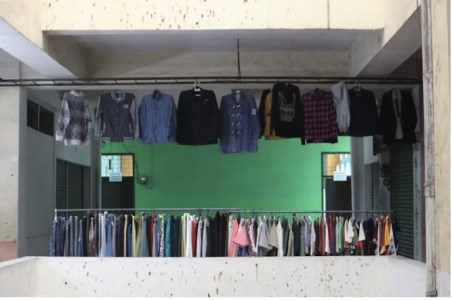Secondhand fashion may outsmart tariffs—and save your wallet
- Replies 0
As tensions rise over global trade, American shoppers may soon feel the squeeze—right in their closets.
With tariffs poised to drive up prices on new clothes and leather goods, finding ways to stretch a dollar has never been more important.
Clothing in the US is largely produced overseas, meaning proposed tariffs could trigger sticker shock at the register.
Analysts at the Yale University Budget Lab estimate that prices could surge by as much as 65% for new apparel and up to 87% for leather items.
Those increases don’t just hit luxury labels—they impact everyday essentials too.
In uncertain times like these, experts say resale platforms, thrift stores, and off-price retailers could become key players in the way we shop.
Long gone are the days when resale meant dusty racks and unpredictable sizing. Today’s secondhand scene is sleek, searchable, and surprisingly stylish.
Online marketplaces like ThredUp, Poshmark, and Mercari have made it easier than ever to shop—and sell—preloved fashion.
Kristen Classi-Zummo, apparel industry analyst at Circana, says that even as the broader market slows, resale is expected to grow. “What I think is going to continue to win in this chaotic environment are channels that bring value,” she explains.
Whether it’s about saving money or reducing waste, more Americans are turning to pre-owned fashion as both a financial strategy and a sustainable lifestyle choice.
The secondhand boom isn’t just happening at your local Goodwill. A new wave of digital tools is making resale more accessible to shoppers of all ages.

Between January and March of this year, downloads for nine major resale apps—including Poshmark, eBay, and The RealReal—increased by 3%, marking their first quarterly jump in three years.
Manish Chandra, CEO of Poshmark, noted that while his company hasn’t seen a dramatic uptick in sales yet, it’s investing in improved features—like visual search tools—to prepare for shifts in consumer behavior.
These tools will “pay long dividends in terms of disruption that happens in the market,” he said, especially as tariffs begin to influence market dynamics.
And it’s not just resale apps getting in on the action. Brands themselves are eyeing secondhand opportunities.
Emily Gittins, CEO of Archive—a company that helps retailers build resale channels—says more fashion labels are looking to tap into inventory already sitting in American closets or warehouses.
“There’s a huge amount of uncertainty,” Gittins explained. “Everyone believes this is going to be hugely damaging to consumer goods brands that sell in the US So resale is basically where everyone’s head is going.”
Stores like TJ Maxx and Burlington, which specialize in domestic overstock, are also expected to weather tariff-related turbulence better than traditional retail. Their business model, focused on unsold goods already located in the US, gives them an edge as global costs climb.
Still, even the resale market isn’t entirely immune. Rachel Kibbe, CEO of Circular Services Group, pointed out that if tariffs expand to cover used goods from the EU, for instance, costs could climb.
Her organization is working to secure a tariff exemption for secondhand and recycled items that are destined for resale in the US
Changes to international policy are already impacting how resellers source inventory.
Trump’s previous decision to end the duty-free status for low-value parcels from China, for example, made importing cheap fast fashion more expensive—effectively boosting the appeal of secondhand alternatives.
James Reinhart, CEO of ThredUp, said some tariff changes, like removing the “de minimis” provision, would benefit his platform.
But he’s skeptical that big brands will embrace resale at scale. “They’re going to be figuring out how to survive,” Reinhart said. “And I don’t think resale helps you survive.”
Others are already adapting. Rebag, a luxury resale chain, expects tariffs to drive more customers through its doors. CEO Charles Gorra said they plan to open more physical stores.
While prices for new designer handbags continue to rise, resale values haven’t always kept pace—something Gorra says could soon change as buyers seek alternatives.
Source: Uptin / TikTok
Even younger consumers are getting involved. Norah Brotman, a 22-year-old university student, buys most of her wardrobe secondhand and sells on platforms like Depop.
If higher prices discourage disposable fashion habits, she says, that might be a good thing. “I would love if this would steer people in a different direction,” she added.
Ultimately, while tariff policy continues to evolve, the shift toward secondhand shopping reflects a broader transformation in how Americans think about value, sustainability, and style.
And for those looking to save money—or simply shop smarter—this growing market offers more than just lower prices. It offers options.
Also read:
 Have you scored a deal through a resale site or found a gem at your neighborhood consignment store? Are tariffs changing the way you think about fashion? We want to hear your thoughts—and your best secondhand shopping tips—in the comments below.
Have you scored a deal through a resale site or found a gem at your neighborhood consignment store? Are tariffs changing the way you think about fashion? We want to hear your thoughts—and your best secondhand shopping tips—in the comments below.
With tariffs poised to drive up prices on new clothes and leather goods, finding ways to stretch a dollar has never been more important.
Clothing in the US is largely produced overseas, meaning proposed tariffs could trigger sticker shock at the register.
Analysts at the Yale University Budget Lab estimate that prices could surge by as much as 65% for new apparel and up to 87% for leather items.
Those increases don’t just hit luxury labels—they impact everyday essentials too.
In uncertain times like these, experts say resale platforms, thrift stores, and off-price retailers could become key players in the way we shop.
Long gone are the days when resale meant dusty racks and unpredictable sizing. Today’s secondhand scene is sleek, searchable, and surprisingly stylish.
Online marketplaces like ThredUp, Poshmark, and Mercari have made it easier than ever to shop—and sell—preloved fashion.
Kristen Classi-Zummo, apparel industry analyst at Circana, says that even as the broader market slows, resale is expected to grow. “What I think is going to continue to win in this chaotic environment are channels that bring value,” she explains.
Whether it’s about saving money or reducing waste, more Americans are turning to pre-owned fashion as both a financial strategy and a sustainable lifestyle choice.
The secondhand boom isn’t just happening at your local Goodwill. A new wave of digital tools is making resale more accessible to shoppers of all ages.

A new wave of digital tools is making resale more accessible to shoppers of all ages. Image source: Acele / Unsplash
Between January and March of this year, downloads for nine major resale apps—including Poshmark, eBay, and The RealReal—increased by 3%, marking their first quarterly jump in three years.
Manish Chandra, CEO of Poshmark, noted that while his company hasn’t seen a dramatic uptick in sales yet, it’s investing in improved features—like visual search tools—to prepare for shifts in consumer behavior.
These tools will “pay long dividends in terms of disruption that happens in the market,” he said, especially as tariffs begin to influence market dynamics.
And it’s not just resale apps getting in on the action. Brands themselves are eyeing secondhand opportunities.
Emily Gittins, CEO of Archive—a company that helps retailers build resale channels—says more fashion labels are looking to tap into inventory already sitting in American closets or warehouses.
“There’s a huge amount of uncertainty,” Gittins explained. “Everyone believes this is going to be hugely damaging to consumer goods brands that sell in the US So resale is basically where everyone’s head is going.”
Stores like TJ Maxx and Burlington, which specialize in domestic overstock, are also expected to weather tariff-related turbulence better than traditional retail. Their business model, focused on unsold goods already located in the US, gives them an edge as global costs climb.
Still, even the resale market isn’t entirely immune. Rachel Kibbe, CEO of Circular Services Group, pointed out that if tariffs expand to cover used goods from the EU, for instance, costs could climb.
Her organization is working to secure a tariff exemption for secondhand and recycled items that are destined for resale in the US
Changes to international policy are already impacting how resellers source inventory.
Trump’s previous decision to end the duty-free status for low-value parcels from China, for example, made importing cheap fast fashion more expensive—effectively boosting the appeal of secondhand alternatives.
James Reinhart, CEO of ThredUp, said some tariff changes, like removing the “de minimis” provision, would benefit his platform.
But he’s skeptical that big brands will embrace resale at scale. “They’re going to be figuring out how to survive,” Reinhart said. “And I don’t think resale helps you survive.”
Others are already adapting. Rebag, a luxury resale chain, expects tariffs to drive more customers through its doors. CEO Charles Gorra said they plan to open more physical stores.
While prices for new designer handbags continue to rise, resale values haven’t always kept pace—something Gorra says could soon change as buyers seek alternatives.
Source: Uptin / TikTok
Even younger consumers are getting involved. Norah Brotman, a 22-year-old university student, buys most of her wardrobe secondhand and sells on platforms like Depop.
If higher prices discourage disposable fashion habits, she says, that might be a good thing. “I would love if this would steer people in a different direction,” she added.
Ultimately, while tariff policy continues to evolve, the shift toward secondhand shopping reflects a broader transformation in how Americans think about value, sustainability, and style.
And for those looking to save money—or simply shop smarter—this growing market offers more than just lower prices. It offers options.
Also read:
- Tariffs on the rise: Experts warn of sharp price hikes—here’s what you can do
- This man bought a $2.99 thrift store bracelet and couldn't believe its shocking true value—find out what it's really worth!
Key Takeaways
- New tariffs on imported clothing could raise consumer prices by up to 65% for apparel and 87% for leather goods, according to the Yale University Budget Lab.
- Secondhand markets, including resale apps and thrift stores, may see increased demand as shoppers look for affordable alternatives.
- Data shows resale app downloads are rising again for the first time in three years, signaling growing consumer interest.
- Luxury brands and off-price retailers are also pivoting to meet demand, using resale as a way to navigate potential supply chain disruptions.






